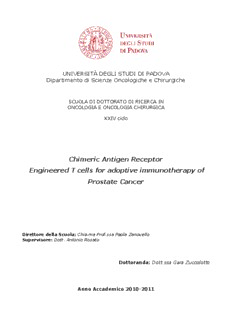
Chimeric Antigen Receptor Engineered T cells for adoptive PDF
Preview Chimeric Antigen Receptor Engineered T cells for adoptive
UNIVERSITÀ DEGLI STUDI DI PADOVA Dipartimento di Scienze Oncologiche e Chirurgiche SCUOLA DI DOTTORATO DI RICERCA IN ONCOLOGIA E ONCOLOGIA CHIRURGICA XXIV ciclo Chimeric Antigen Receptor Engineered T cells for adoptive immunotherapy of Prostate Cancer Direttore della Scuola: Chia.ma Prof.ssa Paola Zanovello Supervisore: Dott. Antonio Rosato Dottoranda: Dott.ssa Gaia Zuccolotto Anno Accademico 2010-2011 "Le difficoltà crescono a misura che ci si avvicini alla meta. Seminare non è così difficile come raccogliere." W.Goethe Index INDEX SUMMARY 7 RIASSUNTO 9 INTRODUCTION 11 1. CANCER IMMUNOTHERAPY 11 2. ANTI-TUMOR VACCINATION 17 2.1 Current vaccination strategies 18 3. PASSIVE IMMUNOTHERAPY: ADOPTIVE T CELL THERAPY 22 3.1 Genetic modification using TCR genes 23 3.2 Chimeric antigen receptors (CARs) 26 4. T-BODY 26 4.1 Design of chimeric antigen receptor 28 4.2 First and later generation CARs 28 4.3 Clinical trials 29 5. LENTIVIRAL VECTORS 31 6. CANCER IMAGING 35 6.1 Principles of bioluminescence 36 6.2 Limitations 38 6.3 T cells tracking 39 AIM OF THE PROJECT 41 MATERIALS AND METODS 43 1. CELL LINES 43 2. PBMC 43 3. CAR ANTI-hPSMA GENERATION 43 4. VECTORS 44 5. CAR ANTI-hPSMA GENE TRANSFER by 293T CELLS 46 TRANSFECTION 6. WESTERN BLOTTING 46 7. CONSTRUCTION AND GENERATION OF LENTIVIRAL 47 VECTORS 7.1 minCMV-Luciferase cloning into transfer lentiviral vector 47 7.2 CAR anti-hPSMA cloning in transfer lentiviral vectors 47 7.3 Sequencing 49 8. VIRAL PRODUCTION 49 8.1 Viral particles titration 50 9. CAR ANTI-hPSMA GENE TRANSFER IN JURKAT T CELLS BY 51 TRANSDUCTION WITH LENTIVIRAL VECTORS 10. CAR ANTI-hPSMA GENE TRANSFER IN PRIMARY T CELLS 51 BY TRANSDUCTION WITH LENTIVIRAL VECTORS 11. ANTIGENIC STIMULATION OF THE LYMPHOCYTE T 51 TRANSDUCED WITH CAR ANTI-hPSMA 12. FLOW CYTOMETRY ANALYSIS 52 12.1 eGFP expression analysis 52 12.2 Assessment of anti-hPSMA CAR expression 52 12.3 Evaluation of transduced T cell phenotype 52 12.4 Flow cytometry analysis of intracytoplasmic IFN-g production 53 12.5 Evaluation of hPSMA antigen expression in tumor cells 53 13. 51CR RELEASE ASSAY 53 14. CONSTRUCTION AND GENERATION OF LUCIFERASE- 54 ENCODING LENTIVIRAL PARTICLES 15. GENERATION OF LUCIFERASE-POSITIVE TUMOUR CELL 54 LINES 16. MICE 55 17. WINN ASSAY 55 18. ADOPTIVE TRANSFER OF TRANDUCED LYMPHOCYTE 55 5 Index 19. OPTICAL IMAGING (Bioluminescence) 56 19.1 Bioluminescence (BLI) 56 19.2 IVIS Lumina II 56 19.3 Analysis of the Cells expressing the enzime Firefly Luciferase. 57 19.4 Animal analysis. 58 RESULTS 59 1. CAR ANTI-hPSMA GENERATION 59 2.EXPRESSION ANALYSIS OF ANTI-hPSMA CAR BY 59 TRASFECTION 3. DEVELOPMENT OF EFFICIENT BIDIRECTIONAL LV FOR CAR 60 ANTI-hPSMA GENERATION 4. ASSESSMENT OF CAR EXPRESSION BY LENTIVIRAL 62 VECTORS 4.1 Jurkat cell line 62 4.2 PBMC 63 5. PHENOTYPICAL AND FUNCTIONAL CHARACTERIZATION OF 63 T CELLS POPULATION TRANSDUCED WITH THE CAR 5.1 Phenotypical characterization 63 5.2 Functional characterization 64 6. EVALUATION OF IN VIVO THERAPEUTIC EFFICACY 66 6.1 Winn Assay 66 6.2 Assessment of therapeutic efficacy of anti-hPSMA T-body Administration against established Subcutaneous prostate 68 Tumors 6.3 Assessment of therapeutic efficacy of anti-hPSMA T-body 72 Administration against disseminated prostate Tumors DISCUSSION 75 ABBREVIATIONS 81 BIBLIOGRAPHY 83 PUBBLICATIONS 95 AKNOWLEDGMENTS 97 6 Summary SUMMARY Immunology-based interventions have been proposed as a promising curative chance to effectively attack postoperative minimal residual disease and distant metastatic localizations of prostate tumors. In this regard, however, results from clinical trials have shown that a single-approach immunotherapy (antibody- mediated or cell-mediated) might be insufficient to eradicate tumor cells and allows them to survive and adapt to the body’s defence mechanisms or to passively administered cures. The aim of my PhD project was the generation of CAR- engineered T cells specific for the human Prostate Specific Membrane Antigen (hPSMA), and their funtional evaluation in vitro and in vivo. We exploited the concept that combination of two powerful tools, by endowing T cells with recognition capacity and high specificity of antibodies, can lead to results superior to those obtained by single-approach treatments. To this aim, we developed a CAR containing both the CD3zeta and CD28 signalling moieties fused to a scFv targeting the hPSMA, to engineer human PBMC for the immunotherapy of prostate cancer. As a transfer method, we employed last-generation lentiviral vectors (LV) carrying a synthetic bidirectional promoter, capable of robust and coordinated expression of two transgenes, thus allowing to co-express the CAR in conjunction with a reporter gene (luciferase), to track the transgenic T cell population to the tumor site by in vivo optical imaging after adoptive transfer. Overall, we demonstrated that CAR-expressing LV efficiently transduced short-term activated PBMC that, in turn, were readily stimulated to produce cytokines and exert a relevant cytotoxic activity by engagement with PSMA+ prostate tumor cells. Then, we exploited our in vivo imaging know-how and set up some experiments to precisely define the effect of the Tbodies in tumour-grafted mice and to visualize their effect in a mouse model of prostate cancer. To this end, tumour cells were transduced with a lentiviral vector coding for the reporter gene luciferase. Stably transduced cells were then used for the in vivo experiments as described above. For the analysis, mice were anaesthetized and injected with luciferin, the substrate of the enzime luciferase: the catabolyc reaction produced bioluminescence that can be visualized using Ivis Lumina II instrument (Xenogen). Last, for the setting up of a prostate cancer mouse model, we injected s.c. and i.v. luciferase-transduced PC3-hPSMA cells or PC3-WT as control. Than we evaluated the therapeutic efficacy of the Tbodies after local and systemical injection. Mice were analyzed weekly, using the Ivis Lumina II platform. 7 Summary Upon in vivo transfer in tumor-bearing mice, CAR-engineered T cells survived shortly but were nonetheless capable of inducing striking therapeutic effects, thus supporting the transfer of this approach to clinical settings. 8
Description: